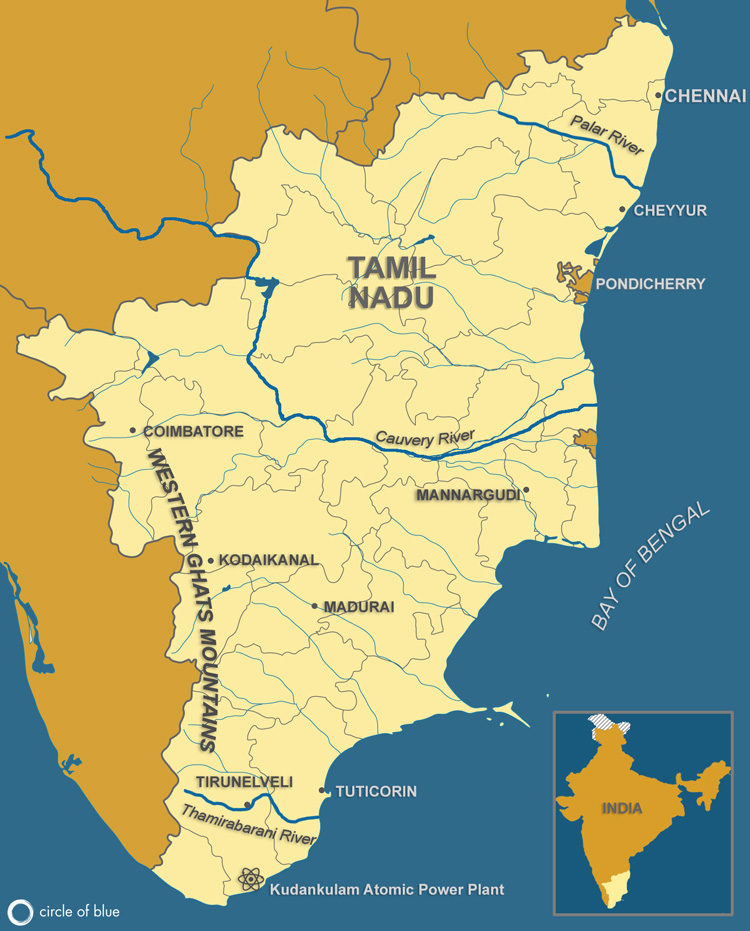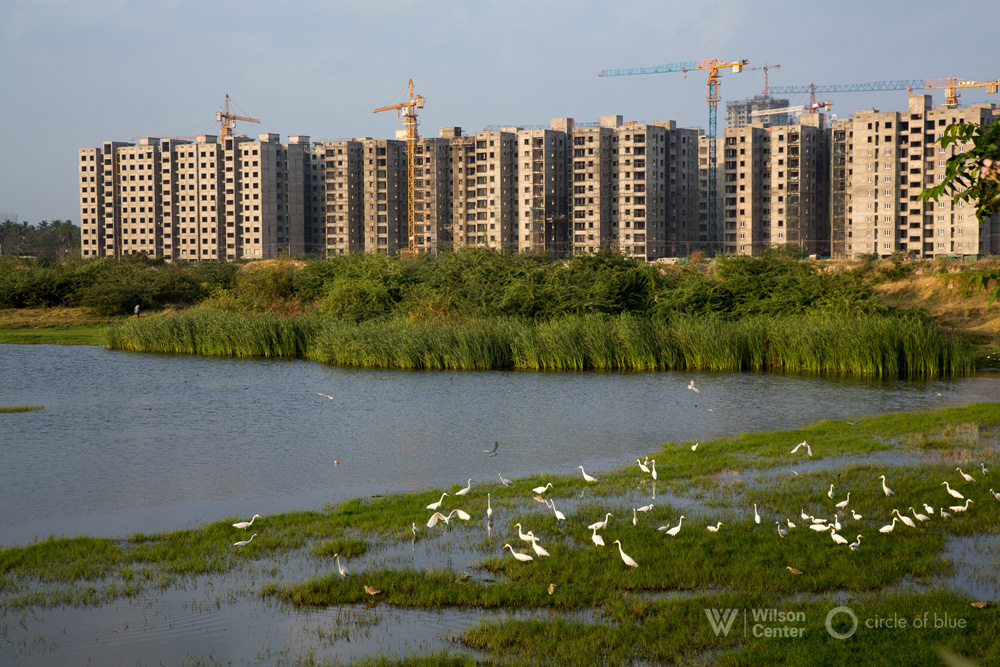-
Facing Floods, Social Entrepreneurs Push Chennai to Consider New Growth Strategy
May 1, 2017 By S. Gopikrishna WarrierBefore the 2015 floods that drowned Chennai, Pradeep John spent several years posting thorough and dutifully accurate updates and alerts on Twitter and Facebook as the Tamil Nadu Weatherman. An amateur meteorologist who developed considerable expertise in weather data and satellite imagery, John’s online followers relied on his crisp forecasts and advice.
“Do not step out unless really necessary,” he wrote in one typical note. “Keep your phones charged, this seems to be a long spell,” he said in another.
The 34-year-old weatherman, though, did not fully appreciate how popular his reports were until November 15, 2015, during the third of what would ultimately be five spells of torrential rain that killed more than 400 residents and brought Chennai to a standstill for weeks. John received a message that day on WhatsApp about an expert who predicted more rain and realized with a shock that the post was referencing him. Web traffic monitors indicated that 250,000 people in and around flooded Chennai were following his posts.
“My messages helped people to take immediate decisions,” said John in an interview. “I could tell them which parts of the city would get rain, how long it would last, and how intense it would be.”
A Citizen-Driven Movement
John is part of a growing community of savvy young professionals that has helped spur much of Chennai’s rapid development as a center of information and manufacturing technology. But popular online forums in Chennai are also helping residents understand how competing trends in hydrology, weather, land use, and development are putting the metropolitan region’s 10 million residents – and many of its businesses – at risk. In guiding residents through the complexities of ecology and urban design, web activists and entrepreneurs are a pushing city authorities to update Chennai’s growth-at-any-cost development strategy.
John’s work, for instance, bridges the gap between the daily and weekly forecasts of the India Meteorological Department, published on its website, and the real-time information needs of those living in Chennai’s most flood-prone neighborhoods.
 Another group, Citizens Platform, has turned to mapping development patterns around the city’s lakes to deepen understanding of flood-related disasters. The intent is to improve public knowledge about how construction patterns affect drainage.
Another group, Citizens Platform, has turned to mapping development patterns around the city’s lakes to deepen understanding of flood-related disasters. The intent is to improve public knowledge about how construction patterns affect drainage.A third group, led by Arun Ganesh, a 29-year-old digital mapmaker, developed a street-level map of Chennai that incorporates crowd-sourced information about what roads are inundated, by how much, and where to find relief camps. The map went live on December 1, 2015. Not only were residents able to avoid the most dangerous flood zones, the city learned which areas were the first to flood and to what depth.
“It was the first time a street-level disaster mapping exercise was being carried out,” said Ganesh. “Our map was immediately picked up by Chennai residents and at any given time during the floods there were at least 100 people accessing it. Flooding was reported from 15,000 road segments, and in the two weeks of its launch it had registered 1.2 million views.”
In displaying command of data gathering and forecasting, these and other projects have put residents and city leaders on notice that Chennai’s rambunctious development, which has spread across the city’s table-flat geography and consumed much of its water-absorbing marshes and natural areas, has become particularly vulnerable to dangerous new climate conditions. Even in a 400-year-old coastal city accustomed to periodic cyclones, wet winters, and dry summers, severe weather is pushing the city to embrace new designs for growth that are safer.
In the Path of Peril
Located on the eastern seaboard of the Indian peninsula, facing the Bay of Bengal, Chennai is in the direct path of weather events that are increasing in intensity, according to regional modeling studies carried out for the Tamil Nadu State Action Plan on Climate Change. The plan projects that the average annual maximum temperature for Tamil Nadu could increase by 3.1 degrees Celsius (five degrees Fahrenheit) by 2100 compared to the 1970-2000 baseline. Average annual rainfall, on the other hand, could decline by up to nine percent. Rainfall patterns could also shift, bringing more intense cyclones and floods, followed by long periods of drought.
The city, as currently laid out, is ill-prepared for such dramatic changes. The 2015 floods and the 2016/2017 drought have proved that point.
There was nowhere for the water to flow but into buildings, homes, and the streetsThe long period of dry weather over the last year has cut water levels in the four reservoirs that serve Chennai – Poondi, Cholavaram, Red Hills, and Chembarambakkam – by alarming amounts. As of this writing, they hold a mere 11 percent of their capacity, and the city utility, Chennai Metro Water, is able to supply less than half of its typical 1.1 million-cubic meter daily flow to residents and businesses.
Damage from the flooding is worse. The last major flood in Chennai before 2015 was in 2005. In the decade between the two events, Chennai changed markedly. The city’s economic growth engine ran in overdrive and the metro region swelled by roughly 250,000 people a year. Entire new sections of the city appeared, including the IT corridor in the city’s southern district, replaced water-absorbing marshland and natural areas with pavement and buildings. Large parts of Pallikaranai Marsh, the city’s largest wetland, were filled in with unplanned construction. The Old Mahabalipuram Road, linking Chennai to the historic town of Mahabalipuram, was reclaimed from the adjoining wetlands and turned into an expressway. More office buildings rose along the corridor.
New residents, middle class and poor, crowded into the floodplains of the three rivers that flow from west to east through the city – the Kosasthalaiyar, Cooum, and Adyar. Overburdened sewage treatment plants poured raw wastes into the rivers, filling them with sludge that reduced their drainage capacity. The city’s old and inadequate storm drainage networks overflowed during even modest downpours.
When five heavy rainfall events happened between November 8 and December 5, 2015, there was nowhere for the water to flow but into buildings, homes, and the streets. Floodwaters at the city’s international airport were so deep that small planes floated away.
A New Operating Strategy
Chennai city authorities have long been aware of the increasing menace that the disruptive 21st-century climate poses for the area. For years they have held periodic public forums and meetings with academic experts to consider ideas to guide development.
To better manage minor flooding, Chennai is adding modern storm-water drains to its urban drainage network, for example – though the work is expensive and slow.
City leaders have also embraced desalination to help solve the water scarcity dilemma. Chennai has two operating desalination plants capable of producing about 200,000 cubic meters (52.8 million gallons) of freshwater per day. A third could be completed by 2020 and a fourth is planned.
In order to reduce demand on freshwater, two sewage treatment plants will soon start tertiary treatment and convert 45 million liters of wastewater a day (11.8 million gallons) to water usable for industry. A large program to replace conventional street and traffic lighting with high-efficiency LEDs, meanwhile, is intended to reduce demand from water-intensive coal-fired power plants.
Chennai has also developed a rainwater collection and storage program and encouraged water-conserving techniques in construction and manufacturing.
Choices that residents are making about where to live, such as in neighborhoods less prone to severe flooding, are aided by construction of a new subway system that opened in 2015. New lines are being added and the $2.25 billion system is expected to have 45 kilometers of tracks (28 miles) and 32 stations when completed in 2018.
“Civil Society Had to Move In”
But city leaders are less enthusiastic about taming Chennai’s sprawl, which is paving over more and more ground. Residents said in interviews that it still only takes a moderate rain to cause storm drains to overflow across much of the city. Persistent flooding and associates losses could cause the city to lose its reputation as one of Asia’s best places to live and do business.
That’s where Pradeep John and other young professionals come in. Their work is helping to elevate the urgency of Chennai’s water-logged condition.
The breakthrough was that social media became a tool for conveying reliable informationArun Ganesh was surprised and thrilled by how online viewers responded to his flood maps in 2015, and the website continues to give the city vital data about where its flood prevention efforts need to improve.
“The breakthrough during the 2015 floods was that social media became a tool for conveying reliable information,” said Divya Ganeshan, a 29-year-old city resident who teamed up with her friends to establish a community kitchen for stranded people. Their effort was strengthened by a group of Tamils working in Bengaluru, the capital of neighboring Karnataka, where a call center coordinated relief programs.
John, Ganesh, Ganeshan, and others proved so effective at setting up informal networks that government officials took notice. The Bengaluru call center informally blended the efforts of government officials with citizen volunteers. P. Manivannan, an administrative service officer who was then the managing director of the Karnataka Urban Water Supply and Drainage Board, coordinated the joint efforts. “By using the expertise with the government and the volunteers, we could force-multiply the communication and support network with Chennai,” he said.
“The intensity of the 2015 flood and the enormity of efforts that were needed to deal with it brought the citizens out to innovate and find new ways to communicate and support,” said Vaishnavi Jayakumar, co-founder of The Banyan, a non-government organization that works with the mentally ill in Chennai. “We have always been used to the government being in charge and the civil society helping out. In 2015, we realized the government just cannot reach everywhere and the civil society had to move in.”
The conflicting demand for water, food, and energy is one of the defining challenges of the 21st century. Global Choke Point, a collaboration between Circle of Blue and the Wilson Center, explores the peril and promise of this nexus with frontline reporting, data, and policy expertise. “Choke Point: Tamil Nadu” is supported by the U.S. Consulate General in Chennai. Jayshree Vencatesan of Care Earth Trust, Nityanand Jayaraman, and Amirtharaj Stephen provided expertise and invaluable guidance.
Gopikrishna Warrier is a Chennai-based environmental journalist.
Sources: Chennai Metro Rail Limited, Chennai Metropolitan Water Supply and Sewage Board, Government of Tamil Nadu.
Photo Credits: Used with permission courtesy of Dhruv Malhotra/Circle of Blue. Map: Cody Pope/Circle of Blue.
 A Publication of the Stimson Center.
A Publication of the Stimson Center.







